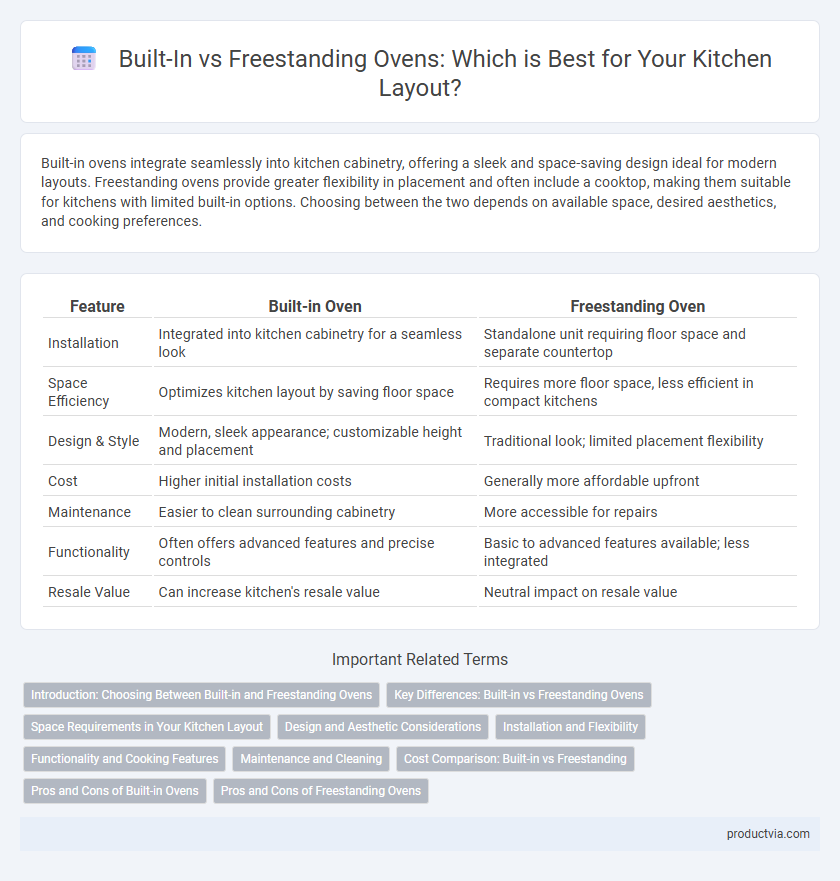Built-in ovens integrate seamlessly into kitchen cabinetry, offering a sleek and space-saving design ideal for modern layouts. Freestanding ovens provide greater flexibility in placement and often include a cooktop, making them suitable for kitchens with limited built-in options. Choosing between the two depends on available space, desired aesthetics, and cooking preferences.
Table of Comparison
| Feature | Built-in Oven | Freestanding Oven |
|---|---|---|
| Installation | Integrated into kitchen cabinetry for a seamless look | Standalone unit requiring floor space and separate countertop |
| Space Efficiency | Optimizes kitchen layout by saving floor space | Requires more floor space, less efficient in compact kitchens |
| Design & Style | Modern, sleek appearance; customizable height and placement | Traditional look; limited placement flexibility |
| Cost | Higher initial installation costs | Generally more affordable upfront |
| Maintenance | Easier to clean surrounding cabinetry | More accessible for repairs |
| Functionality | Often offers advanced features and precise controls | Basic to advanced features available; less integrated |
| Resale Value | Can increase kitchen's resale value | Neutral impact on resale value |
Introduction: Choosing Between Built-in and Freestanding Ovens
Built-in ovens maximize kitchen space and provide a sleek, integrated look, perfect for modern layouts and customized cabinetry. Freestanding ovens offer flexibility in placement and often combine cooktop and oven functions, making them ideal for smaller or temporary kitchens. Selecting between these options depends on design preferences, kitchen size, and how each model complements cooking habits.
Key Differences: Built-in vs Freestanding Ovens
Built-in ovens are integrated seamlessly into kitchen cabinetry, offering a sleek and custom look while saving counter space. Freestanding ovens combine an oven and cooktop in a single unit, providing flexibility for various kitchen layouts and easier installation. Built-in models often feature more advanced technology and precise temperature control, whereas freestanding ovens are typically more affordable and easier to replace.
Space Requirements in Your Kitchen Layout
Built-in ovens maximize kitchen space by integrating seamlessly into cabinetry, ideal for smaller or custom layouts where counter space preservation is crucial. Freestanding ovens require designated floor space and clearance around the unit, which can limit flexibility in compact kitchens. Careful measurement of available space and planning for ventilation are essential to optimize functionality and flow in your kitchen design.
Design and Aesthetic Considerations
Built-in ovens create a seamless, integrated look by fitting flush with cabinetry, enhancing modern kitchen design and saving countertop space. Freestanding ovens offer flexibility and ease of installation, serving as a focal point with their distinct, standalone presence. Selecting between the two depends on kitchen layout priorities, available space, and desired style cohesion.
Installation and Flexibility
Built-in ovens offer seamless integration into cabinetry, optimizing kitchen space and providing a sleek, custom look ideal for fixed layouts. Freestanding ovens require minimal installation, allowing easy relocation and greater flexibility for kitchen rearrangements or rental properties. Choosing between built-in and freestanding ovens hinges on balancing aesthetic integration with adaptability to changing kitchen designs.
Functionality and Cooking Features
Built-in ovens offer seamless integration into kitchen cabinetry, optimizing space and providing a streamlined look, while freestanding ovens provide flexibility in placement and often include a cooktop for multifunctional cooking. Built-in models typically feature advanced cooking technologies such as convection fans, precise temperature controls, and smart connectivity, enhancing functionality and cooking precision. Freestanding ovens are favored for their versatility and ease of installation, making them ideal for kitchen layouts that require mobility or limited built-in options.
Maintenance and Cleaning
Built-in ovens offer easier cleaning with seamless integration into cabinetry, reducing dust and grease buildup on surrounding surfaces. Freestanding ovens require more frequent cleaning around and behind the unit due to gaps that collect dirt and grease. Maintenance for built-in models often involves fewer issues since their fixed position limits movement and wear on connections.
Cost Comparison: Built-in vs Freestanding
Built-in ovens typically have higher upfront costs due to their custom installation requirements and integration with cabinetry. Freestanding ovens are generally more affordable, offering easier installation and flexibility in kitchen layout without additional carpentry expenses. Long-term energy efficiency and potential resale value may influence overall cost-effectiveness between built-in and freestanding models.
Pros and Cons of Built-in Ovens
Built-in ovens offer a sleek, integrated appearance that saves countertop space and allows for customizable kitchen layouts, enhancing overall aesthetic appeal. They provide ergonomic benefits by enabling installation at eye or waist level, reducing the need to bend, but installation can be more complex and costly compared to freestanding ovens. However, built-in models often have limited mobility and replacement options, requiring careful measurement and planning to ensure compatibility with kitchen cabinetry.
Pros and Cons of Freestanding Ovens
Freestanding ovens offer versatile placement options, making them ideal for kitchens with limited built-in cabinetry or flexible layouts. They typically combine both cooktop and oven in one unit, simplifying installation and providing cost-effective solutions. However, freestanding ovens may lack the seamless integration and custom aesthetic of built-in models, and their size can limit kitchen design flexibility.
Built-in vs Freestanding for kitchen layout Infographic

 productvia.com
productvia.com